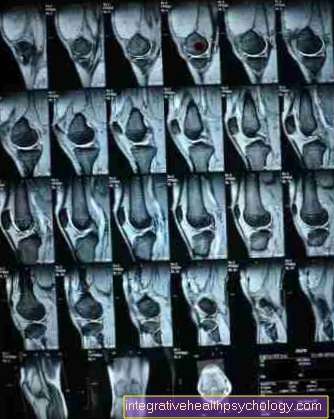Metastases
introduction
A metastasis in the medical sense is understood to mean two different clinical pictures with a similar background:
Dem Separation of tumor cells from the primary tumor and Colonization of tissues remote from the tumor and the Settling bacteria from the original focus of inflammation.
The former is discussed below.
definition
A metastasis is one daughter tumor derived from a primary tumorwhich has been spatially separated from the latter by being carried over by blood and lymph vessels, but is still similar or identical in terms of cell type and cell function.
Emergence

The formation of metastases is a very complex process, which has not yet been clarified in detail, but current in the context of cancer treatment strongly in the focus of medical research stands.
One of the main properties of tumor cells is besides the "degeneration“, Ie the functional profile that differs from the original fabric massively increased division rate. Tumors grow faster and have a different function than the surrounding tissue. Most also have tumor cells fewer so-called adhesion molecules („Adhesive proteins“That anchor cells firmly in their natural environment) than their original cells less stable cell complexes.
If a primary tumor is now expanding and making contact with blood- or. Lymphatics, it can now go to Carryover of the tumor cells into foreign tissue sections and the settlement and emergence of a Secondary tumor, a metastasis, to lead. This process is called metastasis. If tumor cells get through the blood into other tissues, one speaks of the "hematogenous“ scattering, the equivalent for the lymphatic system is lymphogenic spread. When carried through the blood and lymph systems, the tumor cells benefit from the fact that they are in principle „body's own“Origin are and so not from immune system recognized as strange and pathogenic. Of course, the tumor cells that have been carried over need other properties for settlement in the new tissue, such as the ability to get into the to incorporate new tissue sections, to cling to and here the prevailing conditions adapt.
If a tumor cell that has been carried over has these properties, it enters a new body compartment and can settle there, increased they are here again faster than that Host tissue, also stimulates an increased Formation of small blood vessels (Capillaries) in the area of influence to (increased angiogenesis) and displaces the actual functional tissue over time.
One distinguishes local metastases, regional metastases and Distant metastases.
Local metastases arise in immediate neighborhood to the primary tumor. They get through small gaps in the cell structure into the neighboring organ and settle there.
Regional metastases denote by the Lymphatic system entrained tumor cells that are deposited in the subsequent lymph nodes and their surrounding tissues. Depending on the organ of origin of the primary tumor, there are the lymphatic channels following typical deposition sites for regional metastases.
If tumor cells get into the bloodstream and are carried away, this is known as Distant metastasis. Here, too, there are specific locations of the distant metastases for various primary tumors.
Factors
Not every primary tumor has the same potential to metastasize. This depends on the one hand Type of tumor and the Properties of the tumor cells from, on the other hand, from the patient's body, in particular from the patient's immune system.
The prerequisite for metastasis is always the so-called "Invasiveness“Of the primary tumor, so the ability surrounding it blood- and Lymphatics to infiltrate.
Tumors that lack the property of invasion are by definition benign (benign), if they have this they are called them vicious (malignant).
In addition to invading vascular pathways, tumor cells must be able to detach themselves from the original primary tumor; they do this via a decreased number of adhesion molecules on their cell membranes, they must survive the attacks of the immune system in the blood or for this as not pathogenic (making you sick) apply and they must be able to adhere to the new tissue, this happens via certain adhesive proteins, "Integrins“And ultimately be able to adapt to the conditions there.
This is countered by the body's natural defense. Depending on the type of spreading tumor cells, these are recognized by the immune system or not. If a tumor cell has the above-mentioned properties and enters the vascular system, it is difficult for our own defense these cells from good body cells too distinguishbecause the tumor cells are derived from them. Furthermore, tumor cells that divide quickly contribute special surface protein (CD 44) which signals to the body that this is a cell that legitimately changes its place and does not erroneously multiply so quickly.
Nevertheless, our immune system also recognizes metastatic tumor cells and eliminates them. If our immune system is now weakened and has less capacity to deal with these cells, it is naturally easy for them to get to new host species through the blood and lymph vessels.
Specific metastatic pathways
As already mentioned, there are certain primary tumors depending on the drainage Lymph- and Blood vessels typical places for developing metastases. Also the Surface properties of cancer cells determine the site of metastasis, e.g. metastasize Lung cancer- or Colon cancer cells also occasionally into the adrenal gland, as they find similar tissue conditions there.
The first metastases are found in the breast cancer patients regional lymph nodes of the armpits, In the further course there may also be a spread in Bones, liver, lungs, brain and skin to be watched.
Prostate cancer typically spreads to the bones, lungs, liver, and meninges. In colon cancer, metastasis begins in the liver, lungs and peritoneum, then progresses to the bones and possibly ovaries, and in lung cancer, metastases first develop in the brain, then in the bones, liver and adrenal glands.
therapy
The treatment of metastases is similar to that of the primary tumor, and always aims to remove or destroy the tumor. This will depend on Location, size and differentiation the metastasis through surgical evacuation the affected tissue, chemotherapy or radiotherapy done.
If only neighboring lymph nodes are involved, a targeted removal this and / or radiation lead to therapeutic success.
Bone metastases are targeted by irradiation, and they can get through Drugs that slow bone growthare prevented from growing. If a patient is aware of metastases in different organs / body compartments, a so-called systemic, so one larger-scale therapy treated.
In most cases, a so-called Cytostatic used, i.e. chemotherapy that can be adapted to specific tumor cells.
For cancers that grow in a hormone-dependent manner, such as Breast and testicular tumors, additional suppression of the respective hormone can bring therapeutic success.
forecast
The prognosis for cancer patients who already have metastasis is not easy to make. It depends both on which type the primary tumor is and where he is, as well as from size, number and localization the metastases. A complete healing process can only be observed as long as the metastases and the primary tumor are surgically removed or through Chemo- and or radiotherapy let destroy.
However, this is unfortunately not possible in many cases, because so-called Micrometastasis (incipient metastases of the smallest spatial extent) cannot be diagnosed and thus cannot be treated in a targeted manner.
In these cases, the aim is to slow down the progression of the disease and reduce the symptoms, a so-called palliative therapy.





























